Note
I found this tucked into an antique book. Is there anyway to verify it’s authenticity?
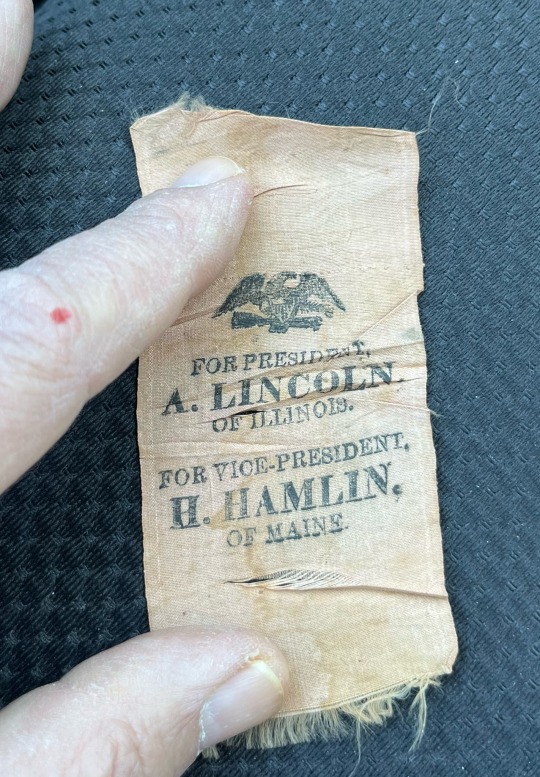
Hi Swedenator!
Because the Lincoln Financial Foundation Collection is an actively collecting collection and must avoid conflict of interest, we cannot appraise or authenticate items. A used or rare item dealer in your area may be able to give you an idea of your item’s value. If you need assistance locating an appraiser, you may contact the American Society of Appraisers at http://www.appraisers.org/find-an-appraiser, phone 800-272-8258, for names of appraisers in your area.
Or you may want to contact Daniel Weinberg at the Abraham Lincoln Book Shop in Chicago http://www.alincolnbookshop.com/, phone 312-944-3085, contact http://alincolnbookshop.com/contact/, email [email protected]. Mr. Weinberg is a dealer and appraiser of Lincoln and Lincoln-related books and other 19th-century materials.
Another alternative is to visit the website of The Rail Splitter (http://railsplitter.com/), an organization of Lincoln collectors and dealers. You can obtain a complimentary informal appraisal by following the instructions on their "Contact Us" page at http://railsplitter.com/?page_id=74 .
11 notes
·
View notes
Text
Spiritualism: The Gateway Between the Living and the Dead
Can you imagine sending your brother, father, grandparent, or friend off to war? The American Civil War, the bloodiest battle in American history, determined what nation we would become. Would we become the largest holder of slaves in the New World, or would we abide by our Declaration of Independence where all men were created with an equal right to life, liberty, and the pursuit of happiness? I think you know how the story ends, but at what cost? Approximately 750,000 lives were lost by the end of the war. During the time after the war, many grief-stricken families turned to a wide spectrum of coping mechanisms. One of them was Spiritualism. Spiritualism, at the time, had 8 million believers in both the United States and Europe. Americans sought comfort in performing séances knowing there was a better life for their loved ones beyond the grave. Believe it or not, Mary Todd Lincoln was one of those forlorn Americans.
At this point, Mary had lost her son Edward in 1850 due to tuberculosis and Willie (her favorite son) in 1862 taken by typhoid fever. She could not overcome the anguish and suffering she felt knowing another son was taken by death. Shortly after his passing, the First Lady was introduced to the Laurie family who were a group of well-known mediums at the time. Thus, diving into the “Spirit World”. Below is a photograph of Mary taken in the year 1862 just after Willie’s death.

Mrs. Lincoln started hosting her own séances in the Red Room of the White House. President Lincoln was in attendance for a few of them in order to support her. She performed as many as 8 séances in the Red Room. Here are pictures taken of the room just after the Lincoln’s versus what it looks like today.

Circa 1869

Circa 2000
Mary Todd Lincoln claimed to have seen both Edward and Willie during her out-of-body experiences. She even believed seeing their spirits at the end of her bed at night, smiling. This brought her great comfort and relief. Due to social pressures, Mrs. Lincoln was forced to take a step back from her Spiritualism practices after several months. Below is a sketched image from Nettie Colburn Maynard’s (a trance medium) 1891 memoir, Was Abraham Lincoln a Spiritualist?

Although Spiritualism can be hard to digest for some people, it was a growing practice throughout the 19th century. Works published on Spiritualism at the time became gateways to the future practice of communicating with the deceased. Much like for Mrs. Lincoln, séances took away the fear of death especially during a time of war. Below is a painting of the Battle of Fort Donelson, and a photo of Abraham Lincoln with General McClellan taken in 1862.


Today, many historians and critics condemn Mary Todd Lincoln for her beliefs and contact with the “Spirit World”. But the truth is, we all turn to anything we can to seek comfort during trying times. Spiritualism played a pivotal role during the 19th century, and it gave Americans the chance to say goodbye to the loved ones who fought in the war.
#spiritualism#séances#marytoddlincoln#abraham lincoln#lincolncollection#lincoln financial foundation
19 notes
·
View notes
Text
A Brief History of Slavery and Frederick Douglass
There are always questions in regard to slavery such as, “When did the first slaves make it to the America’s?”, “Who approved of such cruelty?” Slavery has inhabited every corner of the globe and still lives on today. Our story of slavery begins in the 1400’s after the Portuguese embark on exploring the coast of West Africa. King Charles II legalized the Trans-Atlantic Slave Trade in the mid 1600’s. This aloud the Royal African Company to transport Africans they called “black gold” to the Americas. By this time, plantations in both the Caribbean Islands and America were booming and owners needed an abundance of slaves to maintain their cash crops. As the number of Africans began to diminish from the coast, Europeans moved inland raiding small towns and villages. You can find more information here.
This is an illustrated image published in The Graphic (a popular London illustrated weekly newspaper) that depicts Muslims raiding and kidnapping people in the East Central Africa region.

During the years 1525-1866, 12.5 million Africans were taken from Africa to the New World. Approximately 300,000 of those Africans were shipped to America. The last U.S. slave ship docked in Mobile Bay 3 years before the Emancipation Proclamation was signed by Abraham Lincoln in January of 1863. She was called Clotilda and came with 110-160 slaves. Here is a picture of what the ship looked like and the path it took to get to America.

Among the thousands of slaves that were taken from Africa to America was Frederick Douglass’ family. Frederick Douglass was actually born Frederick Augustus Washington Bailey and was raised a slave. He ran away at age 20 and adopted the surname “Douglas” after Sir Walter Scott’s The Lady of the Lake. He wrote three autobiographies discussing his life as a slave and two additional biographies (My Bondage and My Freedom and The Life and Times of Frederick Douglass) that elevated the southern culture. Below is a picture of Douglass in his younger years.
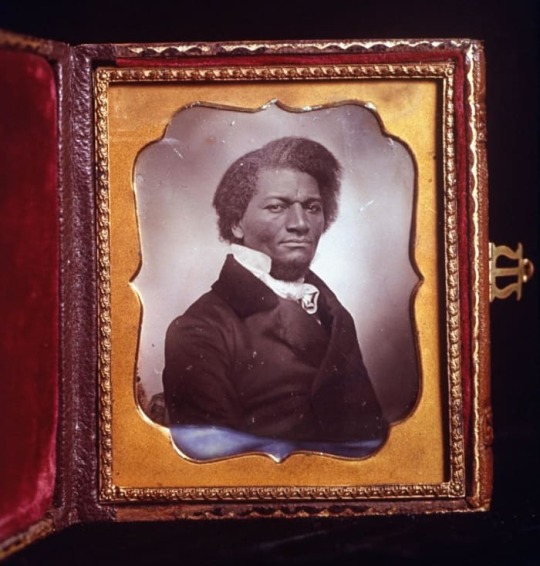
Known as the most important black American leader of the 19th century, Douglass was also a great orator and writer of persuasive power. He was an abolitionist long before the Civil War and even met with President Abraham Lincoln convincing him that “the negro is the stomach of the rebellion”. In other words, if Lincoln frees the slaves he will have more Union soldiers to fight against the Confederacy. After the Emancipation Proclamation takes effect in January of 1863, Douglass recruits black soldiers for the Union. An original hand-signed Leland-Boker edition of the Emancipation Proclamation lives at the Allen County Public Library.
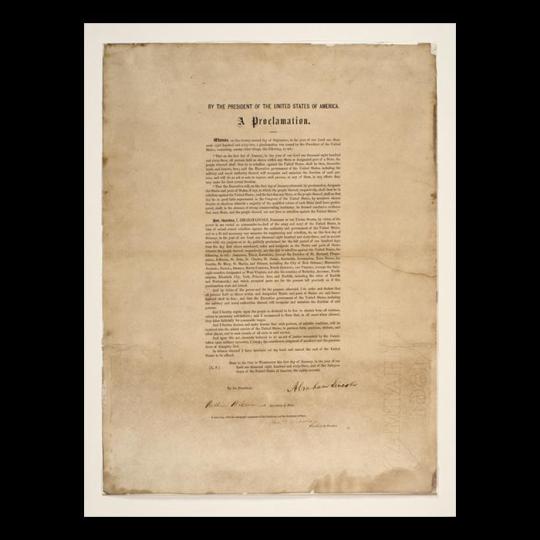
Lincoln valued Douglass’ opinions greatly. Frederick Douglass advocated for issues concerning unequal pay and treatment of African American soldiers and racial inequality. In his book The Life and Times of Frederick Douglass, he wrote,
“Though slavery was abolished, the wrongs of my people were not ended. Though they were not slaves, they were not quite free. No man can be truly free whose liberty is dependent upon the thought, feeling, and actions of others, and who has himself no means in his own hands for guarding, protecting, defecting, and maintaining that liberty.”
Douglass knew the first step to African American independence was the abolishment of slavery, but he knew the equality of whites and blacks would only come with time and with strong leaders to carry-on his legacy. Here is a picture of the abolitionist himself in later years.

In April of 1865, Frederick Douglass along with thousands of people across America mourned the death of President Abraham Lincoln. In Douglass’ eulogy for Lincoln, he strongly states, “…Abraham Lincoln, while unsurpassed in his devotion, to the welfare of the white race, was also in a sense hitherto without example, emphatically the black mans President: the first to show any respect for their rights as men.” Because of this, Douglass gave the citizens of the United States hope for the future; to walk in our martyred President’s footsteps and continue the life Lincoln would have wanted us to live. Below is a picture of Lincoln’s funeral procession in New York.

During Frederick Douglass’ last years he was involved in local politics and served as a marshal for the District of Columbia. His wife of 44 years, Anna Murray, passes away and he remarries Helen Pitts, a white woman. Although his decision to marry Helen stirred controversy, Douglass continued to advocate for the rights of African Americans and even women. He supported Elizabeth Cady Stanton and Susan B. Anthony in their campaign for women suffrage. For reasons such as these we highlight Frederick Douglass’ achievements by composing books to convey his daily struggles and triumphs, teaching it in our classrooms, and continuing to secure the life, liberty, and pursuit of happiness of those Douglass, Lincoln, and many others fought so hard to free.
#abraham lincoln#lincolncollection#lincoln financial foundation#frederick douglass#abolish slavery#womens rights#life#liberty#happiness
13 notes
·
View notes
Text
Abraham Lincoln: A Self-Made Man Through Literature
What is a self-made man? The term was first coined in 1832 by Henry Clay, attorney and lawyer. He represented Kentucky in the U.S. Senate and House of Representatives for over 10 years. He used the phrase “self-made man” to describe individuals of whose success lay within the person themselves, not with outside conditions. One of the most prominent men in history who represented this concept was Benjamin Franklin. He went from a poor, candle maker’s son to a successful businessman and one of America’s most influential Founding Fathers. So, where does Lincoln come in?
Abraham Lincoln was also a self-made man who acknowledged Clay as his “political hero.” He read an abundance of Clay’s political speeches and was greatly influenced by them. Lincoln started reading at a young age and read so much that his parents saw him as “lazy” (Lincoln grew up in a time where working class sons were expected to be working, not leisurely reading. He did go to a local school for brief periods at a time, but he mostly had to stay home and support his family).
Through reading and writing, Lincoln taught himself law and became a lawyer in 1836. His reputation as a lawyer grew and, when he was running for office, his “Honest Abe” persona grew.
A watercolor illustration of what Abe might have looked like at a young age living in Indiana.

Over the course of his lifetime, Abraham Lincoln read over 268 literary works including Shakespeare’s plays, Arabian Nights, Poems by Robert Burns, Journal and Debates of the Federal Constitution by Jonathan Elliot. Many of his own speeches and debates show comments and quotes from other prestigious writers. You can see a full list of what Lincoln read throughout his life as well as more information about the type of literature he enjoyed published through the University of Michigan Library.

Lincoln was known for being an avid reader and most artists liked to represent him as such. One such example of this is in the print by Warren Sallman, Kriebel & Bates.
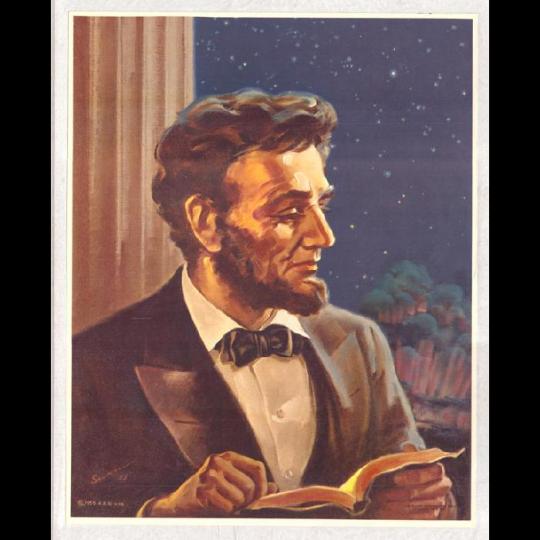
Did you know? While Lincoln was in office from the years 1861-1865, 350 literary works were published in America within that time span including books, poems, plays, and essays.
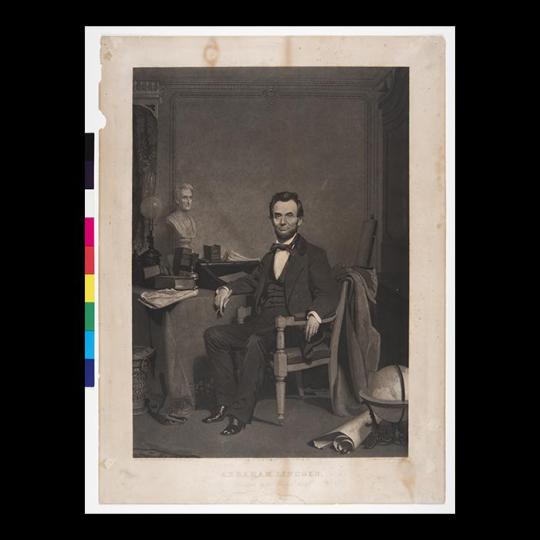
Pictures of Abraham Lincoln almost always include him holding a book or an important document that he had been working on or reading. The picture below shows the capital building in the background as Lincoln is holding an important document.

Abraham Lincoln advocated himself as a self-made man, and literature aided him on his journey to becoming a lawyer as well as one of our greatest presidents in American history.
-K. Mundon, Lincoln Collection Intern
#abrahamlincoln#lincolncollection#thelincolnfinancialfoundationcollection#literature#self-made#henryclay#ourgreatnation
8 notes
·
View notes
Text
12 Days of Lincoln
https://www.facebook.com/LincolnCollection/To have a little fun this holiday season, we wanted to share with our wonderful Tumblr followers our 12 Days of Lincoln countdown a bit early! We know the 12 days of Christmas traditionally refer to the days between Christmas and New Year’s but this year, we’d like to use them as a Lincoln Collection Countdown! Join us for the next 12 days as we highlight interesting items in the collection to a well-loved holiday tune.
On the twelfth day of Christmas, Mr. Lincoln gave to me
Twelve Grants a-coming,

Eleven fifers fifing,

Ten songs of weeping,

Nine ladies dancing,

Eight Tads a-marching,

Seven soldiers singing,

Six McClellans staying,

Five blanket pins,

Four cartoon birds,

Three Dahlgrens,

Two pall bearer gloves

and a Thomas Nast Christmas tree.

For more detailed information about these items and images, check us out this December on Facebook (https://www.facebook.com/LincolnCollection/).
Happy Holidays from the Lincoln Collection!
#Lincoln#abrahamlincoln#christmas#12daysofchristmas#civilwar#lincolncollection#thomasnast#georgemcclellan#usgrant#John A. Dahlgren
3 notes
·
View notes
Text
Family History Month: The Lincoln Grandchildren
October is Family History Month as well as Archives Month, so the Lincoln Collection is excited about having such a great month to show off our collection. We’ll be adding more things about the Lincoln family throughout the month.
Mary “Mamie” Lincoln (1869-1938)
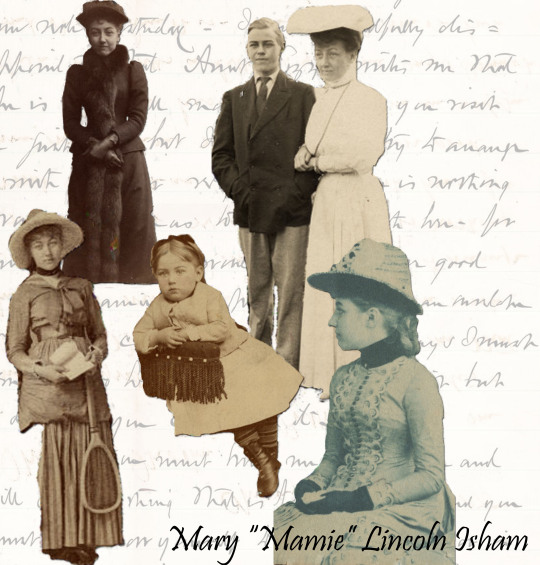
Mary “Mamie” Lincoln, Robert Todd Lincoln’s eldest daughter, was born on October 15th 1869. Mamie would grow up alongside her brother, Jack (Abraham Lincoln II), and sister, Jessie, and would eventually go on to marry Charles Isham and have one son, Lincoln Isham. Mamie spent most of her adult life in New York City and was a choir mother of Grace Church located on Broadway Ave.
Abraham “Jack” Lincoln II

Born in 1873, Jack spent his early years in Chicago with his two sisters, Mamie and Jessie. In 1881, Robert became Secretary of War under Presidents Garfield and Arthur, so the family moved to Washington D.C. At age 16, the Lincolns moved to London because of Robert’s appointment as the ambassador to England. Jack attended school in France, but developed a carbuncle that became infected and caused blood poisoning. Jack died on March 5, 1890 at age 16.
Jessie Lincoln
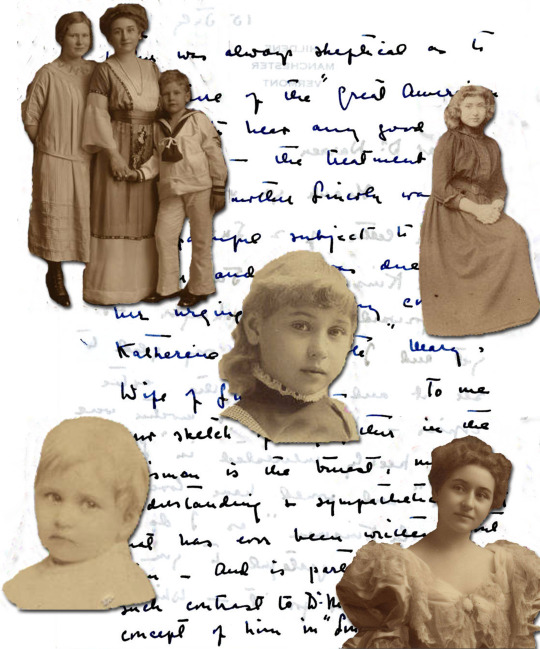
Jessie Harlan Lincoln was the youngest of Robert Todd Lincoln’s children. She was born in Chicago on November 6, 1875 and spent time with her family in Washington D.C. and England with her father’s different government positions. Ultimately, Jessie eloped with Warren Wallace Beckwith and had two children, Mary (Peggy) Lincoln and Robert Todd Lincoln Beckwith (Bud). Jessie went on to divorce Beckwith and marry twice more. In 1946, she moved to the family’s summer estate, Hildene, in Manchester, Vermont. Jessie died in 1948 at the age of 72
#Lincoln#Lincolnfamily#MamieLincoln#JackLincoln#AbrahamLincoln#LincolnCollection#LincolnFinancialFoundationCollection
1 note
·
View note
Text
Spotlight on: Tad Lincoln
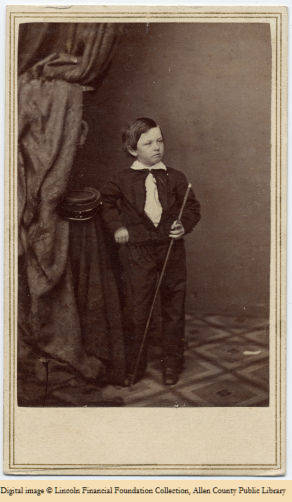
Thomas “Tad” Lincoln was the youngest of the 4 Lincoln children. Born in 1853, Tad was known for being rambunctious and full of energy. Slightly the troublemaker, Tad and his brother Willie were often playmates getting into all sorts of mischief. When Tad and his brother were referred to as “notorious hellions” by Lincoln’s law partner, William Herndon, because they enjoyed pulling apart the law office and dumping books and papers all about the room.

Tad was 7 when his father accepted the presidency and the White House became his and Willie’s new playground. Multiple of the Taft children came over to play and began to form friendships with the new First Family.

In February 1862, both Willie and Tad contracted Typhoid fever. Tad recovered, but lost his older brother to the illness. It was at this point that Mary Lincoln prevented children from coming to play at the White House because it gave her too much pain to hear children laughing and playing after Willie’s death.

On April 14, 1865 Tad went to Grover’s Theatre to see the play Aladdin and the Wonderful Lamp. Tad’s parents were also at the theater that night, but were seeing Our American Cousin at Ford’s Theatre. When new’s of the assassination reached Tad, he began screaming “They killed Papa” and was escorted back to the White House.

After the assassination, Tad, Mary and Robert lived together in Chicago. Robert married and moved out and Mary decided to take Tad to Europe to get out of the states for a bit. Tad attended school in Frankfurt, Germany. When Tad turned 18, he returned to Chicago with his mother but managed to get a cold that turned into something much more serious (potentially pneumonia or congestive heart failure). Tad died on July 15, 1871 at the age of 18.

1 note
·
View note
Text
Belle Boyd: The Confederate Spy
Born on May 9th, 1844, Isabella Maria Boyd was born in Martinsburg, Virginia (which would later become West Virginia). She led a fairly typical life for a girl her age: she attended finishing school in Baltimore and was a relatively normal young woman by the time the Civil War began. It is here where her career in spying begins by chance.

Boyd wrote of her escapades in espionage in a highly exaggerated account, but it details her successes (and ultimate failures) during the Civil War. Her account details the Union forces that came to investigate her house in 1861 because there was rumor that Boyd was housing Confederate flags in her room. She then claims that one of the solider cursed at her mother, which enraged her and forced her to shoot him (he later died, but Boyd was exonerated of murder). The Union forced stationed men around the house, which allowed Boyd to become close to at least one of them (Captain Daniel Keily was the name she gave him in her memoirs).
The stationing of soldiers around her house allowed Boyd to start eavesdropping and learning the ways to pass information. Generally, Boyd passed information to Confederate officers through her slave Eliza Hopewell, who carried the written notes in a hollowed-out watch case. This worked until she was caught early on and threatened with death. She realized she needed a safer route of communication. Belle’s house was located in Martinsburg, West Virginia and has now been made into a museum.
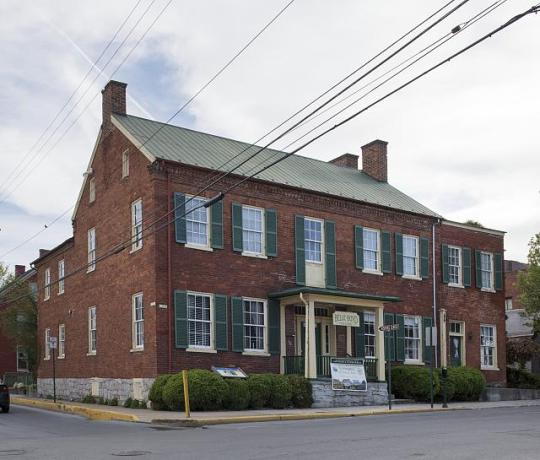
Boyd took sensitive information about Union forces that she had overheard in her parlor directly to Colonel Turner Ashby by bluffing her way through Union lines. For her help, Stonewall Jackson wrote a letter to Boyd saying “"I thank you, for myself and for the army, for the immense service that you have rendered your country today.” She also received the Southern Cross of honor and was awarded a captain and other honorary aide-de-camp positions.
Boyd was arrested at least six times, but managed to avoid jail in each instance. In 1862, Allan Pinkerton, a detective who would go on to create Pinkerton National Detective Agency, assigned 3 men to work the Boyd case to track her down. Boyd continued to evade Pinkerton and his men and began to gain popularity as “La Belle Rebelle” and “the Siren of the Shenandoah” as well as numerous other nicknames.

Though Boyd did exaggerate some of her tales and escapades, she was incredibly famous (and infamous) to both the Union and the Confederate sides. She was hailed as a hero to her rebelling countrymen and was hunted by the North. Boyd was actually arrested 6 times, imprisoned 3 times, and exiled twice. On July 29, 1862, Secretary of War, Edwin Stanton, issues a warrant for her arrest and she was captured and taken to Old Capitol Prison (the current site of the U.S. Supreme Court). She was banished to the Confederate capitol, Richmond. Boyd refused to stay in Richmond and she was arrested again, and banished to Canada, but she decided to head to England instead.

Boyd was more likely in the business to be an adventurer rather than because of her strong commitment to the Confederate ideals. She married two Union men in her lifetime: Samuel Hardinge, a naval officer with whom she had a daughter, Grace, and John Swainston Hammond, with whom she had 4 children (3 that lived past infancy). Boyd published a memoir Belle Boyd in Camp and Prison in 1865 to support herself. She went on to marry Nathaniel High, an actor 17 years younger than her. Boyd was also an actress herself and she died on stage in Wisconsin on June 11, 1900 at age 56.

(All images from The Library of Congress).
1 note
·
View note
Text
Back To School: Looking at Lincoln’s Learning
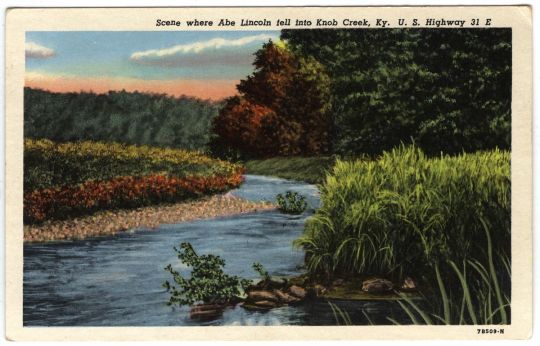
Abraham Lincoln said “my earliest recollection is of the Knob Creek place” in a letter to Samuel Haycraft in 1860. Thomas Lincoln and his family lived on 30 acres of the much larger 228 acres of the Knob Creek Farm. Abraham Lincoln lived here from about 2 and a half years old until he was almost 8, at which point he moved up into Spencer County, Indiana. Young Lincoln grew up and began making some of his earliest memories here. He remembered a stone house he passed while carrying corn up to Hodgen’s Mill, his family’s homestead, a clear stream where he enjoyed fishing, the best places to pick berries, and his first experiences with learning and education.

With so many students and teachers returning to school soon, looking back at Lincoln’s schooling (and lack thereof!) shows some important insight into the 16th president and his learning style that helped him become the president that he would grow to be.

Lincoln spoke of listening to his mother read the Bible and watching her face and she told him stories and it was here at Knob Creek that Lincoln attended school for the first time in his life. For short periods of time, Lincoln and his older sister, Sarah, went to the A, B, C school. The schoolhouse was located about 2 miles north of their home in Knob Creek. When the two Lincolns went to attend school, Abraham was 6 and the classes were only held intermittently. The school had two teachers while Lincoln attended: Zachariah Riney and Caleb Hazel. These frontier schools were subscription or “blab” schools and only lasted for a few months at a time. Free school did not come to Kentucky until the 1830’s.

The learning style Lincoln grew up with is a bit different than current education lesson plans. These “blab” schools were so called because the students would learn their lessons by repeating after the teacher aloud over and over again. This meant that especially reading required students to read aloud. Years later, Lincoln would annoy his law partner, William Herndon, by reading the newspaper out loud because, as he explained, he learned better when he used two senses and because he had learned to process out loud.
When the Lincolns moved to Indiana in December 1816, there were new schools in the area. Abraham and Sara continued their studies as best they could at home until the first school was established year later at Pigeon Creek. This school was about a mile and a quarter south of the Lincoln’s farm and had very meager supplies which meant that there was little learning in the classroom. Lincoln continued to be an avid reader who was toting around books whether he was in school or not. Lincoln read Aesop’s Fables, the Bible, The Pilgrim’s Progress, Robinson Crusoe and Parson Weems’ The Life of Washington. Lincoln also would read the newspaper, hymnals, songbooks, spelling books- basically anything he could get his hands on to.

As Lincoln got older he began to read more challenging works including Shakespeare, poetry, and history. Sometimes, because of his athleticism and his size (6’4” as an adult), Lincoln was perceived as lazy or distracted because of all his reading and writing. Lincoln’s stepmother, Sara, commented that Lincoln did not enjoy physical labor, but he loved to read: “He read so much- was so studious-took so little physical exercise-was so laborious in his studies.”
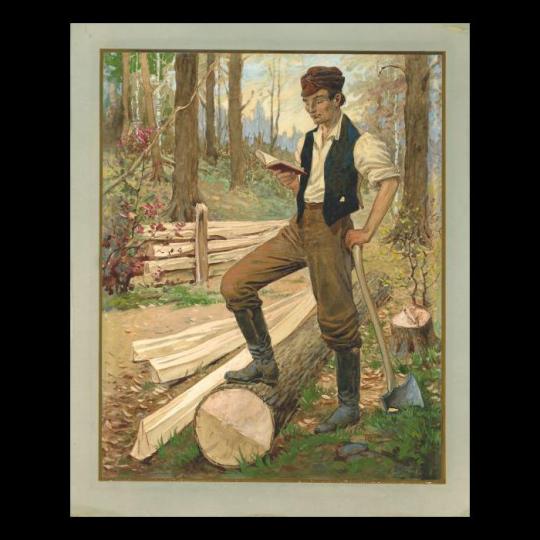
Lincoln’s reading influenced his speaking style as well as his desire to be a ling long learner. Lincoln developed a plain style of speaking that showed a hint of his backwoods upbringing and kept his audiences entertained. Lincoln practiced his orator skills by telling stories and sermon to his family, schoolmates, and members of the local community. By the time he was 21, Lincoln was recognized as “an able and eloquent orator” but he also always carried a bit of his “unrefined” pioneer twang with him throughout his speeches.
8 notes
·
View notes
Text
“Champion Prize Envelope – Lincoln & Davis in 5 Rounds”
Decorated postal envelopes were popular during the mid-nineteenth century and were often collected and placed in special albums as keepsakes. During the Civil War many of these envelopes were illustrated to support the Union war effort. A set of five “Champion Prize Envelope” postal covers published by J.H. Tingley of New York City in 1861 is one example. The envelopes feature cartoons of “Lincoln & Davis in 5 Rounds” showing the Union and Confederate presidents squaring off in a roped-in boxing ring while supporters for each man look on.
In the “1st Round,” a confident Lincoln proclaims, “I use no more force than necessary” and faces a cringing Davis, who whines, “Let me alone!” Lincoln is backed by Secretary of State William Seward, a group of statesmen, and General Winfield Scott as well as Union troops and canon. An American flag flies from the Capitol dome in the background. General P.G.T. Beauregard and Confederate politicians stand with Davis, and the Confederate flag, bales of cotton, dogs, and slaves are in the background. French and British leaders watch the “belligerents” from afar.
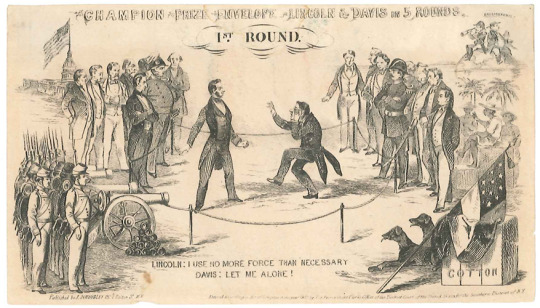
In the “2nd Round,” Lincoln tears Davis's coattail and pants-seat as Davis runs stumbling away with his backside exposed. “Go back you dog to the junction—I’ll call on you there soon,” Lincoln declares. “Beauregard,” Davis says, “Let’s fall back on Richmond.” Union politicians comment, “Secession is looking smaller” and “We shall soon strip it,” while one Confederate bystander asks, “What strategic movement is this?” and another answers, “Only retreating in good order.” Slaves cheer at Davis’s embarrassment and defeat, and the European onlookers declare, “We are drifting into rough waters.”

In the “3rd Round,” Lincoln holds Davis in a headlock and proclaims, “I will soon smother those pirates.” The Confederate spectators flee, trampling the slaves in their path and shouting, “Let’s go home boys” and “Damn Pickens! South Carolina and Sumter too!” Canon balls litter the ring, and the starving dogs run off, abandoning the Confederate flag and cotton. The Union politicians cheer, “General, that’s secession’s last kick” and “See those balls rolling.” The French and British exit as well, noting the effective cotton blockade that the Union has put in place.

The “4th Round” shows Lincoln facing his departing Union troops and declaring, “I have taken the world by surprise.” Seward and Scott stand in the center of the boxing ring. Seward asks Scott, “General, where is secession now?” to which Scott replies, “Don’t you see that grease spot?” The remaining onlookers, including Unionists John J. Crittenden of Kentucky and John M. Botts of Virginia, strain to see what will happen next.

In the “5th Round,” a triumphant Lincoln stands in the “Champion Belt” in front of a pyramid built of all the states topped by an American flag with the letters U.S.A. Men of the North, South, East, and West wave their hats and cheer as Lincoln declares, “You shall all have my impartial, constitutional and humble protection!” The federal eagle holds a ribbon promising “Union Forever,” and Columbia holds a laurel wreath and asserts, “I still live.” Smoke from the canon carries a warning, however: “Traitors beware!! For we still live.”

These illustrated envelopes reveal the Union belief in 1861 that the war against the Confederacy would be short and Davis’s government and army easily defeated. As would soon become clear, however, that was not to be the case.
#abrahamlincoln#jeffersondavis#civilwar#postalcovers#postalcachets#patrioticenvelopes#confederacy#union
5 notes
·
View notes
Text
Presidential Polkas
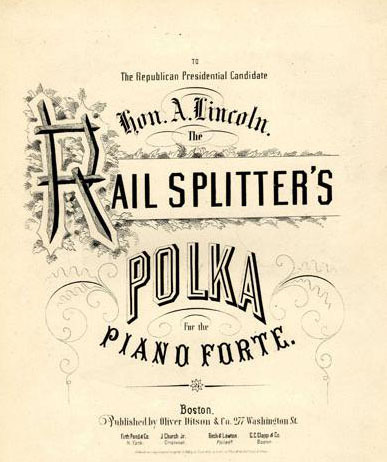
Though the word “polka” brings forth images of accordions, lederhosen, and Oktoberfest, in the 1860’s, polka was a new music trend that was taking Europe and the U.S. by storm. What had started as a folk dance from Bohemia (modern-day Czech Republic) quickly spread across Europe due to the printing of sheet music in the 193o’s. The ability to record the music and share it via sheet music allowed for polka to travel to bands all across Europe. Eventually, the upper classes within the U.S. began to enjoy the new sound from Bohemia. With the influx of immigrants to the U.S. during this period, it’s no surprise that many of them brought along instruments and continued to play music that reminded them of home.
As is true with most songs, the ability to dance as well; and the subject of the music are vitally important. It is of no surprise that many songs have well-known individuals as their topic. The Lincoln Collection has a few polka pieces, generally centered on the 1860 Presidential election. With all the parades, conventions, and speeches, having music to show the prowess and candidacy of someone within the party could be a helpful (and entertaining) push to victory.
For example, “The Rail Splitters Polka” by A. Neuman is one such instrumental polka that focuses around young Lincoln and his “railsplitter” persona.
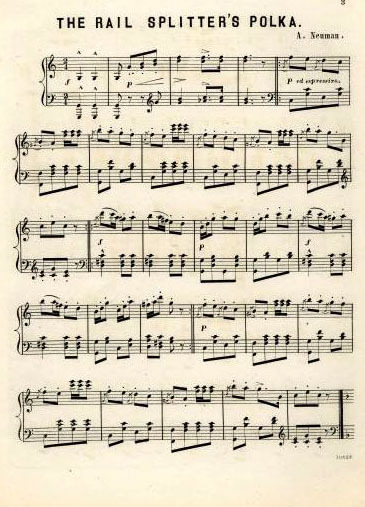
Another example of a Lincoln-related polka is one by the same name as above, the “Rail Splitters Polka” by Harry L. Tatnall.
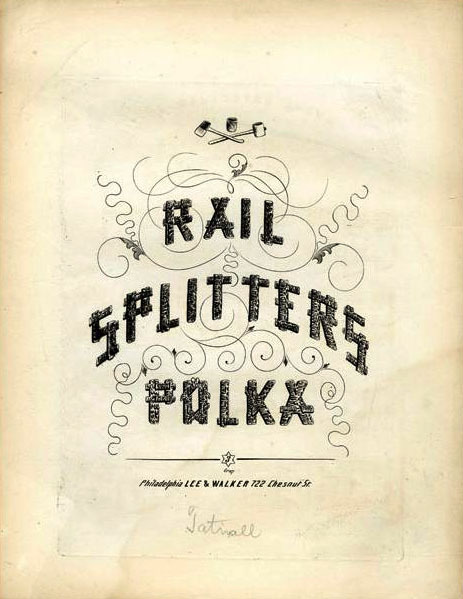
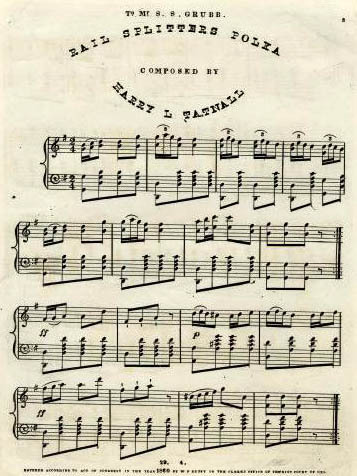
Lincoln was not the only candidate that had his own polka music. In 1860, the “Douglas Polka” was written and published by J. Church Jr. about Stephen Douglas, who was on the Northern Democratic ticket for the presidency.

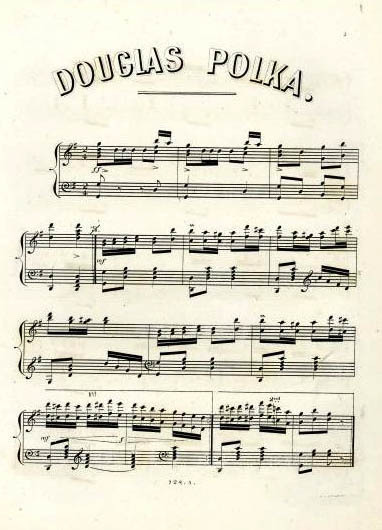
Conventions weren’t the only reason for polka music. Music was composed about events going on, including Sanitary Fairs that were held to raise funds for the United States Sanitary Commission. These uplifting and recognizable sounding songs were both played at the conventions and had their sheet music available afterwards for continued revelry.
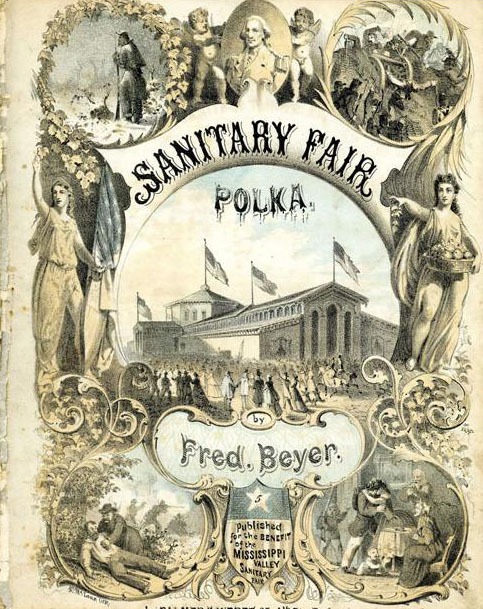
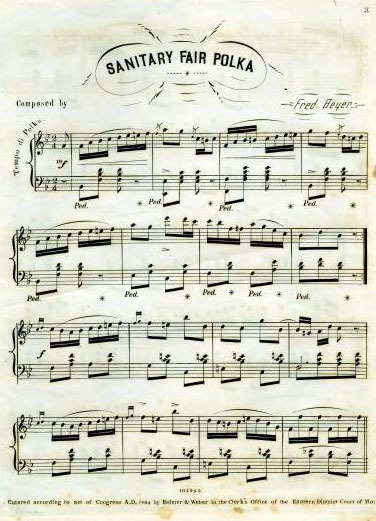
Some polka pieces actually focused on plays that were popular during the day. One is “Our American Cousin Polka”, based on the crowd-pleasing comedy by Tom Taylor. Using popular culture to inform the focus of music, including polka, was not unusual and could also be incorporated in the performances themselves.
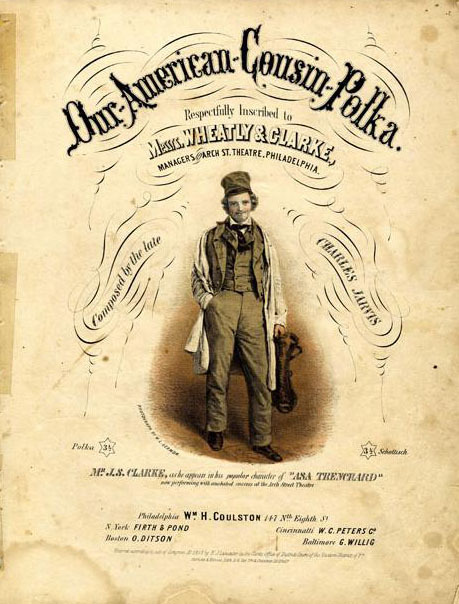
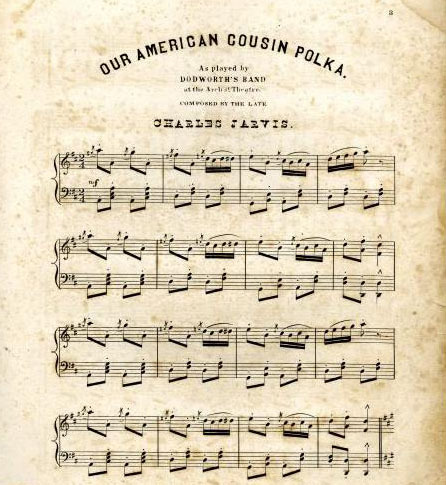
One of the more interesting polka pieces in the Lincoln Collection is one named after Lincoln’s wife: The Mary Todd Lincoln polka. Mary was often criticized for her clothing, decorating, and celebration in a time of warfare (she would have been criticized had she not done any of the aforementioned things, though). With the upcoming White House Ball in February of 1862, Lincoln enlisted Francis M. Scala, the leader of the Marine band, to play at the reception.
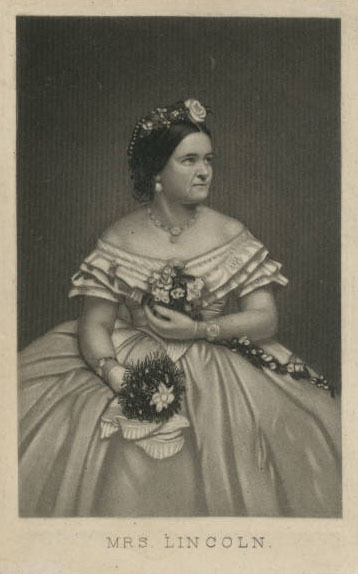
One of the songs played that night was the “Mary Todd Lincoln Polka.” The sheet music was hidden within the Lincoln Collection, and you can hear the full music here: http://contentdm.acpl.lib.in.us/digital/collection/p15155coll1/id/2343/rec/1
3 notes
·
View notes
Text
Did Lincoln REALLY Say That?
Lincoln “quotations” are everywhere — on websites, in social media memes, on greeting cards. They pop up in political speeches, newspaper articles, inspirational books and pamphlets. Sometimes the quotations are accurate ….. and often they are not. Here are some examples of Lincoln quotations printed over the decades on postcards. Can you tell which are accurate? Did Lincoln REALLY say that???
“I feel that I cannot succeed...”

“Let us have faith...”

“You can have no oath...”

“God bless my mother. ...”

“Every man is said...”

“With malice toward none...”

“I have discovered...”

“I do the very best...”

“Do not worry...”

“The leading rule for the man...”

“The brave men, living and dead...”
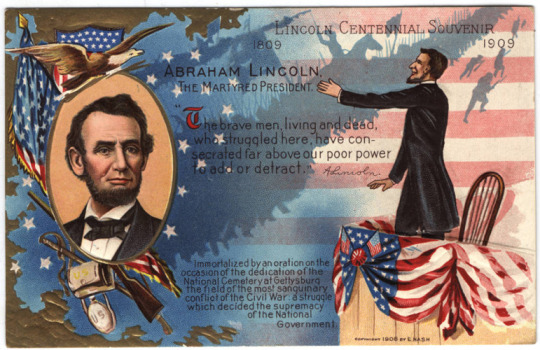
“Whenever any Church...”

“Henceforth a Government...”

“You cannot...”

All postcards are from the Jean Zurow Lincoln Postcard Collection, held by the Lincoln Financial Foundation Collection at Allen County Public Library, Fort Wayne, Indiana.
17 notes
·
View notes
Text
The Lincoln Pilgrimage in Fort Wayne, Indiana
In early 1934, the Lincoln National Life Foundation, a department of Lincoln National Life Insurance Company, announced the first annual Boy Scout Lincoln Pilgrimage to take place on February 12th, the 125th anniversary of Abraham Lincoln’s birth. Pilgrimages were to take place across the country, with Scouts gathering at the nearest statue of Abraham Lincoln. The company’s announcement provided a list of more than 40 cities where heroic statues of Lincoln were located and offered “an attractive award” for each Scout who participated: “It is a beautiful picture of ‘Abraham Lincoln the Hoosier Youth,’ the bronze statue by Paul Manship.” The statue stood outside the Lincoln Life Insurance Company’s headquarters in Fort Wayne, Indiana.
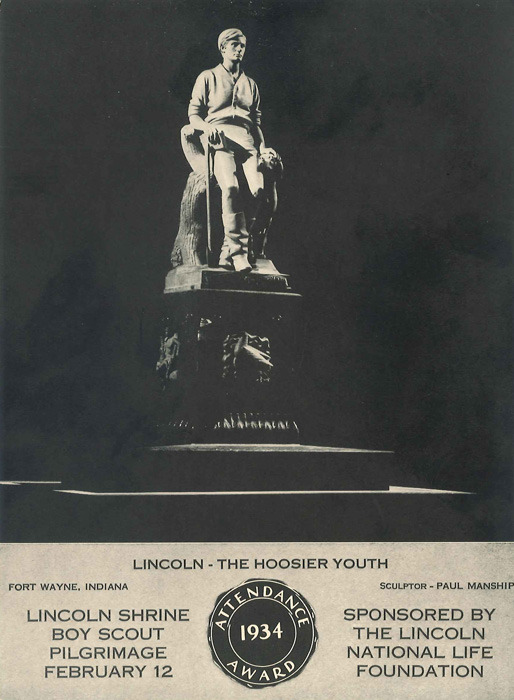
As these photographs show, the Pilgrimage proved to be a popular Scout event, with hundreds of Scouts turning out in the winter weather to march to the statue and participate in a wreath laying ceremony. The Scouts then attended an indoor program and enjoyed refreshments provided by the company.
The 1937 Pilgrimage
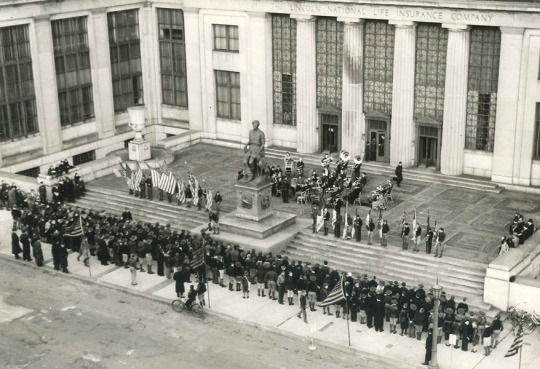
The 1939 Pilgrimage
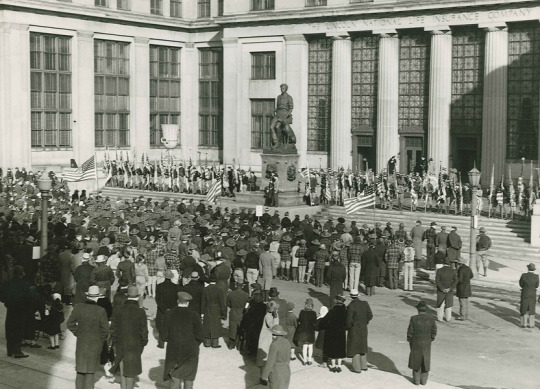
The 1942 Pilgrimage

The 1954 Pilgrimage
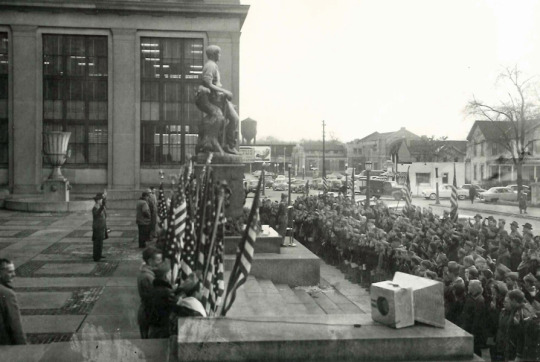
In 1962, the Lincoln National Life Foundation’s publication Lincoln Lore published a list of 81 heroic Lincoln statues and this “Editor’s Note” on the Pilgrimage with illustrations of the awards offered to the Scouts, each picturing an statue of Lincoln in a different location.

In 1970, the Boys Scouts began awarding patches to Pilgrimage participants, in addition to the company’s attendance awards. Several 1970s patches, like this one from 1973, featured the Hoosier Youth statue.

In February 1981, the company’s newsletter reported that both Boy Scouts and Girl Scouts attended the Pilgrimage. There were over 2,100 Scouts participating to learn about “Lincoln’s Midwest Years.”

In 1982 “over 1,400 area Scouts endured snow and cold weather to honor Abraham Lincoln at the 49th Annual Lincoln Pilgrimage,” according to the newsletter.
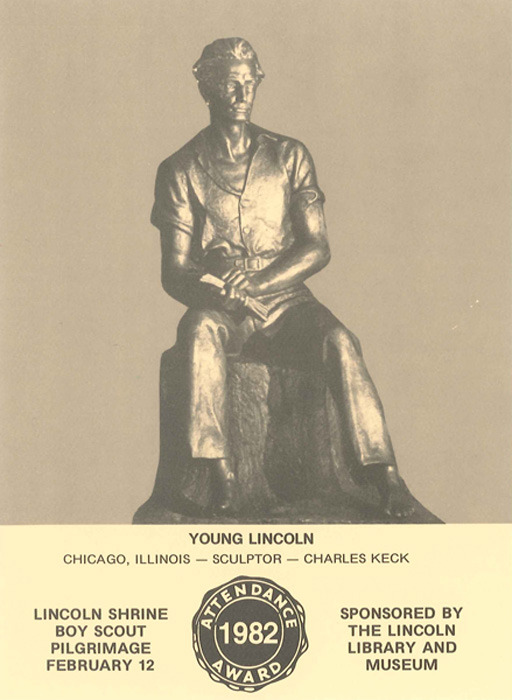
Pilgrimage patches during the 1990s focused on a variety of themes in Lincoln’s life and presidency—Lincoln and education, Lincoln and the law, Lincoln’s family, and once again, Lincoln’s life in Indiana.


The 1993 Pilgrimage commemorated the signing of the 1863 Emancipation Proclamation.

The Pilgrimage continued into the new century, with the patch for 2001 featuring “Long Tall Lincoln” from an 1864 Harper’s Weekly cartoon.

2008 marked the 75th Annual Lincoln Pilgrimage and once again featured the Hoosier Youth statue on the Scout patch.
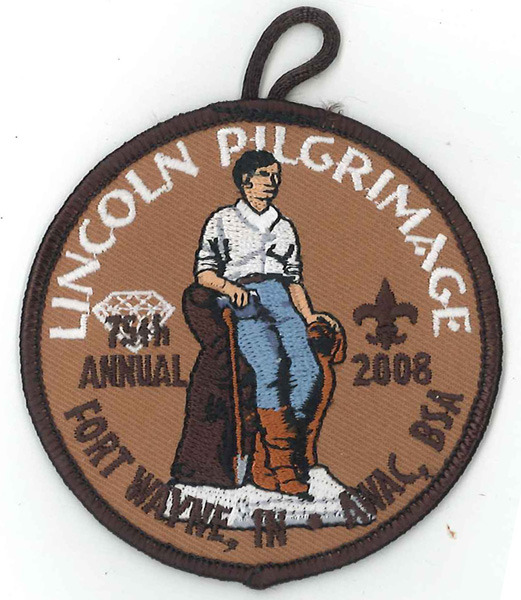
The 2009 Pilgrimage celebrated the bicentennial of Lincoln’ birth with an illustration of Daniel Chester French’s Lincoln Memorial statue on the patch.

2009 also marked the transferal of the collection from the Lincoln Financial Foundation’s Lincoln Museum in Fort Wayne to the State of Indiana and the collection’s renaming as the Lincoln Financial Foundation Collection (LFFC). That ended the company’s support for the Pilgrimage. In 2014, the Allen County Public Library, now co-curator of the LFFC, partnered with the Anthony Wayne Council of Boy Scouts to rejuvenate the Pilgrimage by moving it indoors to the library on the weekend closest to Lincoln’s birthday. Scout interest soon waned, however. The last Lincoln Pilgrimage in Fort Wayne—the 83rd—was held at the library in 2016.

#abrahamlincoln#lincolnpilgrimage#lincolnnationallifeinsurancecompany#hoosieryouthstatue#hoosieryouth
5 notes
·
View notes
Text
Centennial Annoyances, Golf, and a Book for His Granddaughter
As the centennial of Abraham Lincoln’s birth approached, organizations and individuals across the country, especially in the northern states, began to plan memorial events and celebrations to mark the centennial on February 12, 1909. Robert Todd Lincoln, the president’s only surviving son, found himself inundated with requests for his involvement in centennial activities. Letters in the collection of Robert Todd Lincoln Correspondence held by the Lincoln Financial Foundation Collection document his willingness to assist when he can comfortably do so while at the same time politely declining requests for official appearances and speeches.

In March 1908, about the time planning for centennial events was beginning in earnest, Robert wrote a letter to William Stoddard, who had been one of his father’s White House secretaries, and explains himself very clearly.

In his letter, Robert asserts that he doesn’t know very much about the “movement…in regard to the celebration of my father’s centennial birthday anniversary” because he does not “expect to be named or take part in any such matter.” He then goes on, “For myself, I frankly confess that I am rather dreading the year.”


Although he doesn’t refer to the fact in this letter, after Abraham Lincoln’s death, Robert had retained possession and complete control of his father’s papers. He was, therefore, the major source of information for centennial planners. And by early 1908, Robert was receiving many requests for information about his father and the Lincoln presidency. He writes to Stoddard that such requests are giving him “a good deal of trouble” because “a good many [are] requests with which it is very difficult to comply.”
What Robert would rather do as a 65-year-old semi-retired grandfather, he tells Stoddard, is “play golf,” as in this 1910 photograph (Robert is on the far right), and “make the acquaintance of my grand-children.”

And with that assertion, Robert ends his comments on the annoyances of the Lincoln centennial and makes a personal request: He would like Stoddard, who had established himself as a writer of historical fiction for children, to send him two books because “I have a little grand-daughter that I am sure would be very much interested in them.”
Robert does not include the titles of the books, but it seems almost certain that one of them—the one Robert had not yet seen—was The Boy Lincoln, published in 1905.

The granddaughter was Peggy Beckwith, age 10.

1 note
·
View note
Text
Battling the Elements: Weather in the Civil War
As the Civil War raged on, with brother against brother, father against son, and North against South, another war was wreaking havoc on both sides. The outdoor conditions that soldiers were forced to endure throughout the war were brutal and detrimental on a new scale.

As documented in soldiers’ journal entries, letters, and images, being trapped outside in inclement weather was just as damaging as the fighting that continued. Weather forced battle plans to change, tactics to be adjusted, and impeded movements of troops. Because of the lack of accuracy of weather instruments and issues getting information out to the field officers in a quick and timely manner, there were large gaps in the weather predictions and the reality for the soldiers. Winter camps demanded for more concrete living constructions, like log cabins, as well as more trivial duties (picket duty, marching, etc.) rather than full on battles. With the coming of spring, especially April’s fair weather, there was new movement, new campaigns, and a higher morale.
One of the better known weather assaults on a campaign occurred in 1862. Union General George B. McClellan was launching his Peninsula Campaign and was incessantly complaining about the constant rainy weather and the flooding that was continuously occurring. McClellan was attempting to reach Richmond, the Confederate capital, but due to rising river levels, there was constant stalling. Though the engineers of this unit were challenged by the weather, McClellan found that blaming the weather was an easier option than problem solving.

President Lincoln had other idea. He became incredibly frustrated with McClellan and his “impenetrable weather” situation to the point that Lincoln went on to fire McClellan from command by the end of the summer. Lincoln’s frustrations proved valid when, in 1865, William T. Sherman proved that while flooding and river levels were obstacles, they were easy to overcome and work around. His March to the Sea continued and, even though there was massive storming and flooding in South Carolina, Sherman was able to take both Columbia and Charleston.
The main issue with weather during the Civil War was the damage it did to the processes involved in warfare. Besides soldiers being bogged down by wet clothing, soaked socks, and decaying shoes, necessary requirements to fight in a war were inhibited. Gunpowder and paper cartridges became wet and compromised the ability for the weapon to fire accurately. During the Battle of Chantilly in 1862, Stonewall Jackson clashed with Isaac Stevens during a raging thunderstorm. Over 2,000 men fell in ninety minutes (including Union general Philip Kearney, who mistakenly rode behind enemy lines in all the rain-induced confusion). Similar events occurred at the Battle of New Market in 1864, in which the ground became so muddy that the wheat field they were fighting in became dubbed “the field of lost shoes.”

Though storms were certainly an opponent to deal with throughout the war, the heat also proved to be an issue. During the Battle of the Wilderness, the heat caused the forest fires to continue to rage and caused numerous soldiers to collapse on the trek to the Spotsylvania Court House. Heat could also cause tactics to suffer. With the dryness of dirt roads, it became harder for moving armies to cover their tracks. Two days before Stonewall Jackson would flank the confederate forces at the Battle of Chancellorsville in 1863, there were rain storms that prevented dust from being kicked up by the moving army as they marched.
Weather was also one of the most recorded events by soldiers because it was consistently something that impacted their everyday lives. Because most soldiers found themselves transported to new places in the U.S., the changing geography as well as being forced to live outside in flimsy tents was a shock for most soldiers. With the bad weather came the bad morale, as revealed by a large amount of soldiers in their diaries and their letters home. To the soldiers, bad weather also signaled widespread illness (like typhoid, infections, and gangrene) in the camps which led to even lower morale. As written by Solomon Barnes to Elizabeth Barnes: “ March came in like a lam and is gowing out like a lion yesterday was a cold blustery day and today is not enny better it is spitting snow Some at preasant but I look for warm weather as soon."

The weather proved to be an important player during the events of the Civil War. One of the more comical weather incidents, “The Great Snowball Battle,” shows some of the absurdity that weather forced on the troops. In Dalton, GA, Confederate soldiers in the lower ranks took advantage of their unseasonable snow flurries and started a snowball fight. It eventually went on to include officers and entire regiments. When the “battle” ceased, there were some eye injuries, but Confederate general Joseph Johnston took this “battle” as proof of high morale.

With all the variety of weather situations that soldiers were forced to deal with, weather became a strong player in the war that impacted both sides.
3 notes
·
View notes
Text
Private Letters and Presidential Campaigns, 1860 and 1864
The Lincoln Financial Foundation Collection holds the Richard W. Thompson Manuscript Collection, a large collection of letters written to Indiana politician Richard Wigginton Thompson during the course of his career from 1834 to 1897. These include letters from other state and national politicians and provide some interesting private glimpses of 19th-century politics, especially the “backstage” activities surrounding the presidential campaigns of 1860 and 1864.
Thompson (1809-1900) was influential in the Indiana Whig Party from the 1830s through the 1850s, serving two terms in the Indiana House and one in the Indiana Senate before serving two terms in the United States House of Representatives from 1841 to 1843 and 1847 to 1849. As the national debate over slavery heated up during the 1850s and the Whig Party fragmented, Thompson found the new Republican Party to be too radical on the slavery issue. Nonetheless, he remained in contact with former Whigs who had joined the Republicans and who kept him informed of the party’s 1860 campaign—men like John A. Norton of Pennsylvania and Abraham Lincoln of Illinois.

Norton wrote to Thompson in March 1860 describing the unsuccessful machinations of Simon Cameron, a fellow Pennsylvania Republican, at the state Republican Party convention. Cameron had attempted to build support for his nomination to the presidential ticket at the party’s upcoming national convention in June 1860.

Norton did not think highly of Cameron, to say the least. In a letter written on March 26th, he informed Thompson, “That slimy reptile, Simon Cameron has been playing the devil with the politics of our state. He had a powerful majority in the late 22 July state convention, but the minority worked their efforts to thwart him … Simon Cameron can now return to Washington to represent, or more properly speaking misrepresent our state, in the U S senate … a gentleman of our city who went to Harrisburg to watch the proceeding of the late convention opined me that some of the most respectable people in the place did not hesitate to declare boldly & openly, that if Cameron had his deserts, he would be serving out a sentence in the penitentiary instead on serving in the US Senate.”
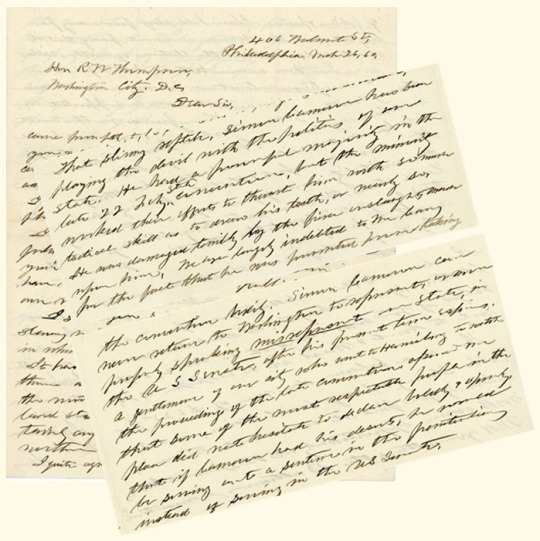
Although he had known Lincoln when they served together in Congress, Thompson’s concerns about the Republicans’ anti-slavery stand led him to support Constitutional Union Party candidate John Bell in the early months of the 1860 presidential campaign. Two letters written to Thompson by Lincoln during the summer of 1860 reveal the Republican candidate’s attempt to gain Thompson’s support and undermine the organizing efforts of the Constitutional Union Party.
On June 18th, Lincoln wrote this brief letter to Thompson, thanking him for a letter Thompson had sent in which he had noted that he might “possibly” vote for Lincoln if the Constitutional Union candidates were not on the Indiana ballot. Lincoln urged Thompson to “converse freely” with Maryland Congressman Henry Winter Davis, who had supported the Constitutional Union Party but who had strong anti-slavery views and had voted with the Republicans in Congress. Lincoln apparently hoped Davis would nudge Thompson toward supporting the Republican ticket and short circuiting attempts to run a Constitutional Union ticket in every state.

Then on July 10th, Lincoln wrote to Thompson again, asking Thompson to “watch Chicago a little,” possibly to prevent a Constitutional Union Party ticket in Illinois, and to contact Lincoln supporter John Wilson to “fix the matter.” This letter is not only marked “Private”—Thompson is instructed to “Burn this,” which obviously he did not do.

As it happened, John Wilson and Thompson had already exchanged letters on the matter. In a “Private” letter of June 16th, Wilson argued against running a Constitutional Union Party ticket in Illinois. He wrote, “Here the question is reduced down to a choice between Douglass and Lincoln,” and nationally Bell “has not the slightest chance of an election.” If the Democratic candidate were to be elected, the consequences would be dire—the result would be “a state of corrupt despotism, licentious agrarianism, or civil war, and possibly all combined, & in comparison to which the despotisms of Russia or Turkey, would be a perfect Paradise.” Wilson concluded, “I have determined to do all in my power, in this State and elsewhere, to secure the election of Lincoln….[and] do all in my power to prevent the running of a Union Ticket.” He urges Thompson abandon the Constitutional Union Party and support Lincoln as well.

Lincoln, Davis, and Wilson were successful in convincing Thompson to join the Republicans. In August of 1860, when it became clear that Constitutional Union Party candidate Bell could not win the election, Thompson declared his support for Lincoln.
Letters to Thompson also reveal some of the “backstage” activity during the 1864 presidential campaign. In the months leading up to the 1864 Republican National Convention, Secretary of the Interior John P. Usher kept Thompson informed about the scandal surrounding the Pomeroy Circular, a secret document shared among Republicans who wanted to replace Lincoln with Secretary of the Treasury Salmon P. Chase as the party’s presidential nominee.

On February 17th Usher wrote, “A secret circular has just been issued signed by Pomeroy Chairman for Chase for President. Mr C must have knowledge of & approved it. It contains reflections upon the President of such an offensive character that there will have to be explanations and will I think cause a rupture in the cabinet, There is such caballing & plotting going on here.”

Not surprisingly, the circular did not remain secret, and it did not build support for Chase. Instead, it made its way into Lincoln’s possession, was published in the newspapers, and caused a scandal within the party. And on February 25th, after publication of the circular, Usher wrote, “I suppose you have seen the Pomeroy Circular and have been amazed that Mr Chase should have allowed such a paper to go to the public. It is a most indecent thing and how a man of strict honour can hold his position as adviser of the President after stating that he disagrees with him on his policy is more than I can tell.” But, he concluded, “I think now that the worst is over. The Pomeroy Circular was so badly conceived and so badly worded that Chase and his friends will have to repudiate it in doing which they substantially give up their cause—Politicians will soon see that the people are for Lincoln and they will make haste to be in that way too.” Usher was correct. When the Republicans held their nominating convention in June, Lincoln was easily nominated for a second term.

You can explore hundreds of additional documents from the Richard W. Thompson Manuscript Collection here.
#richardwthompson#rwthompson#1860election#1864election#abrahamlincoln#republicanpolitics#19thcenturypolitics#politicalcampaigns#johnpusher
1 note
·
View note
Text
Creating Lincoln: Sculptor Daniel Chester French
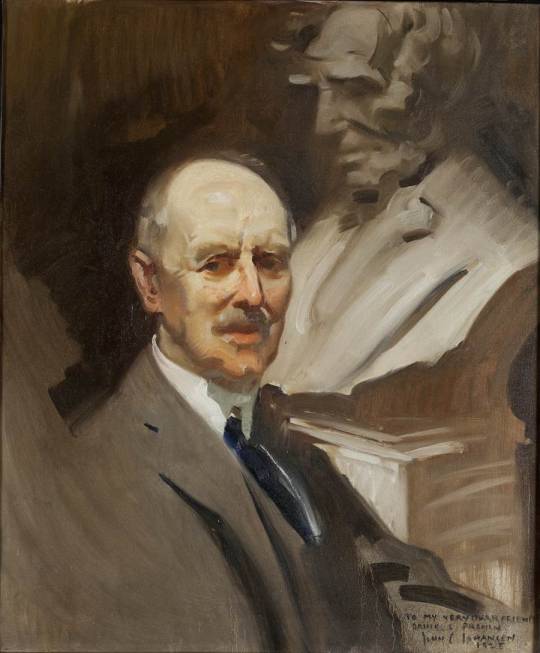
Born in New Hampshire in 1850, Daniel Chester French would grow up to be one of the most famous U.S. sculptors of his time. In 1867, French moved with his family to Concord, Massachusetts where he became a neighbor and friend of Ralph Waldo Emerson and the Alcott family. May Alcott is said to have been the influence pushing French to become a sculptor.
French spent his early training and education with William Rimmer for anatomy and William Morris Hunt for drawing. He then spent a year studying at the Massachusetts Institute of Technology as well as in Florence at the studio of Thomas Ball. In 1875, French gained his first accolades and appreciation for his statue “Minute Man.” This statue was commissioned by the town of Concord, MA and was created to commemorate the battle of Lexington and Concord that had occurred 100 years prior.
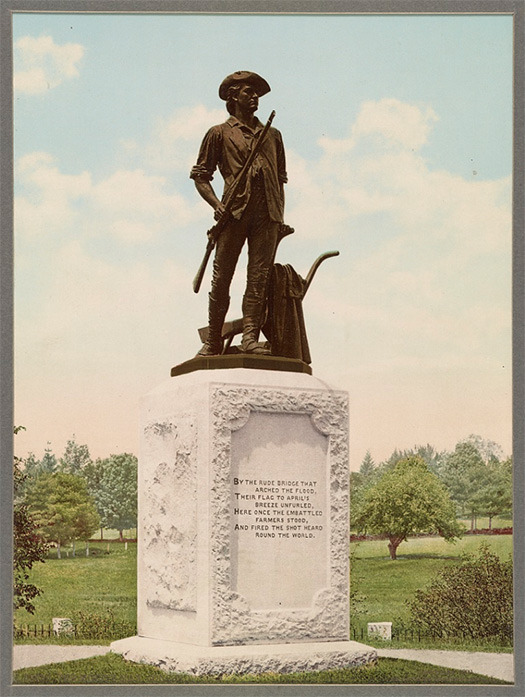
Shortly after the sculpture creation, French opened his first studios: initially in Washington D.C., then moving to Boston, and finally to New York. With the World’s Colombian Exposition of 1893, French’s reputation began to grow as his “Statue of the Republic” gained national acclaim. French then followed this sculpture with other memorable works including: the “First Division Monument” and the “Butt-Millet Memorial Fountain” in Washington; “John Harvard,” Cambridge, Massachusetts; bronze doors for the Boston Public Library; and “The Four Continents” at the US Custom House, New York, which is now the Alexander Hamilton US Custom House.

French’s most popular work is the Lincoln Memorial, which was one of many projects that he collaborated with architect Henry Bacon on. For Indiana, French is known for creating the statue of Beneficence at Ball State University. In 1893, French became one of the founding members of the National Sculpture Society and then was appointed a Fellow of the American Academy of Arts and letters in 1913. In 1917, French and his colleague, H. Augustus Lukeman designed the Pulitzer Prize medal- French specifically designed the side with Benjamin Franklin on it (Image from Pulitzer.org).
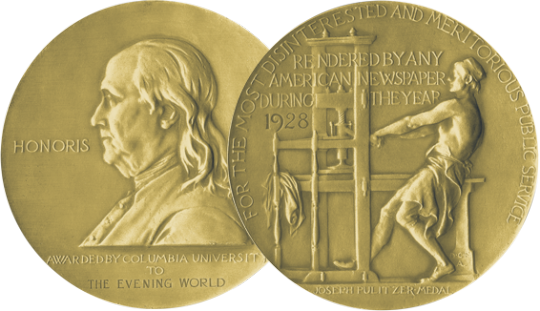
French was known for his collaborations. Besides working with those listed above, French also collaborated with Edward Clark Potter on the statue of George Washington in Paris, the statue of General Grant in Philadelphia, and the statue of General Hooker in Boston. He also worked Walter Leighton Clark and helped to found the Berkshire Playhouse, which later became the Berkshire Theater Festival. (Photo: Library of Congress, LC-USZ62-10017)
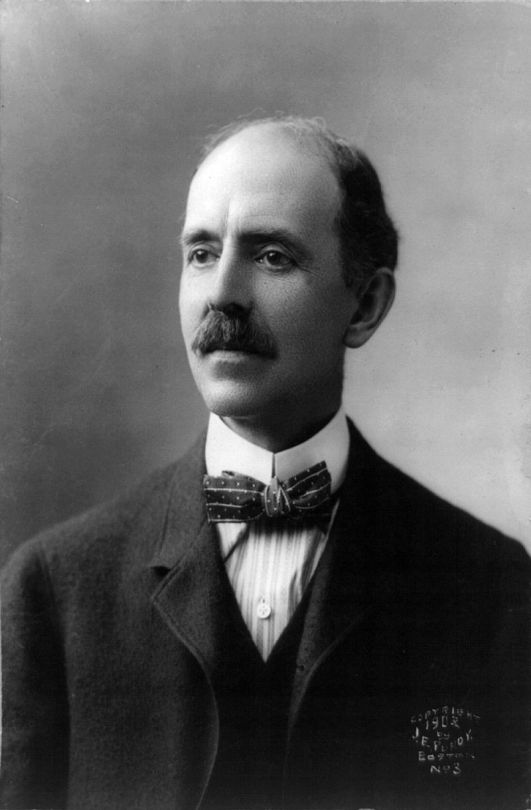
French received an honorary Master of Arts from Harvard after his creation of the statue of Emerson. He continued to sculpt and teach, including sculptor Edith Howland was one of French’s students. Howland was also known for studying under another famous Lincoln sculpture, Augustus Saint-Gaudens. French is also remembered for his estate and summer art studio, Chesterwood, that was designed by his friend and architect, Henry Bacon.

To learn more about Daniel Chester French and his influential friends, and to see images of Chesterwood, check out Harold Holzer’s article on his book “Monument Man: The Life and Art of Daniel Chester French” in “Lincoln Lore” available online here: https://www.friendsofthelincolncollection.org/lincoln-lore/an-interview-with-harold-holzer-on-monument-man/
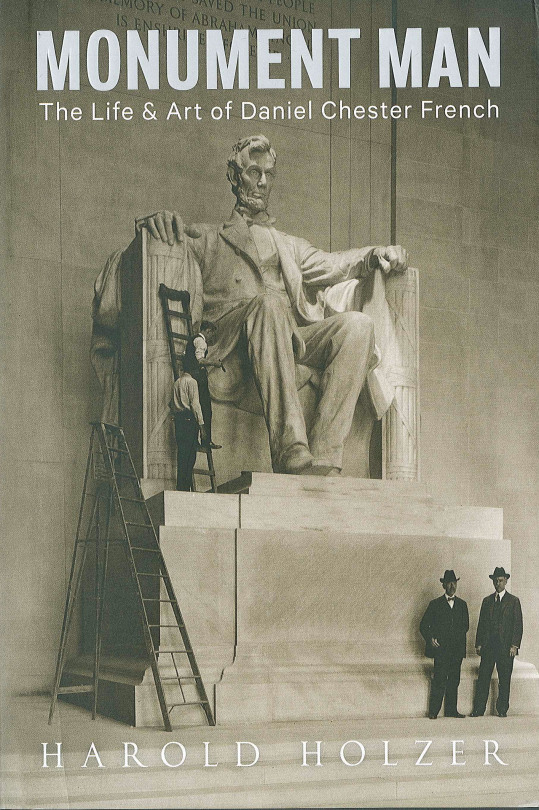
3 notes
·
View notes